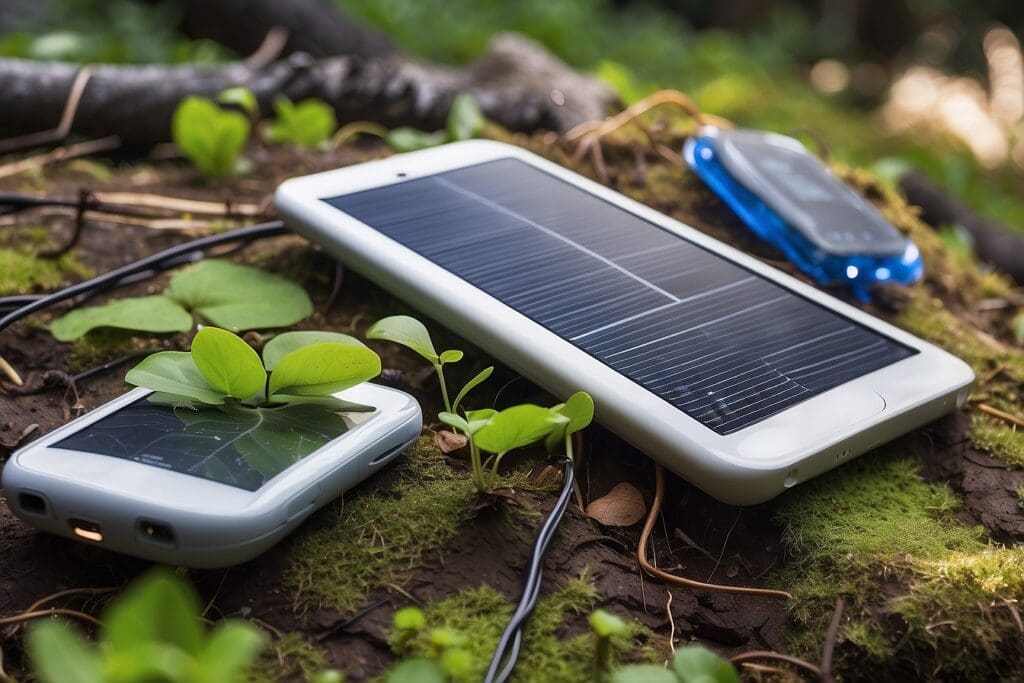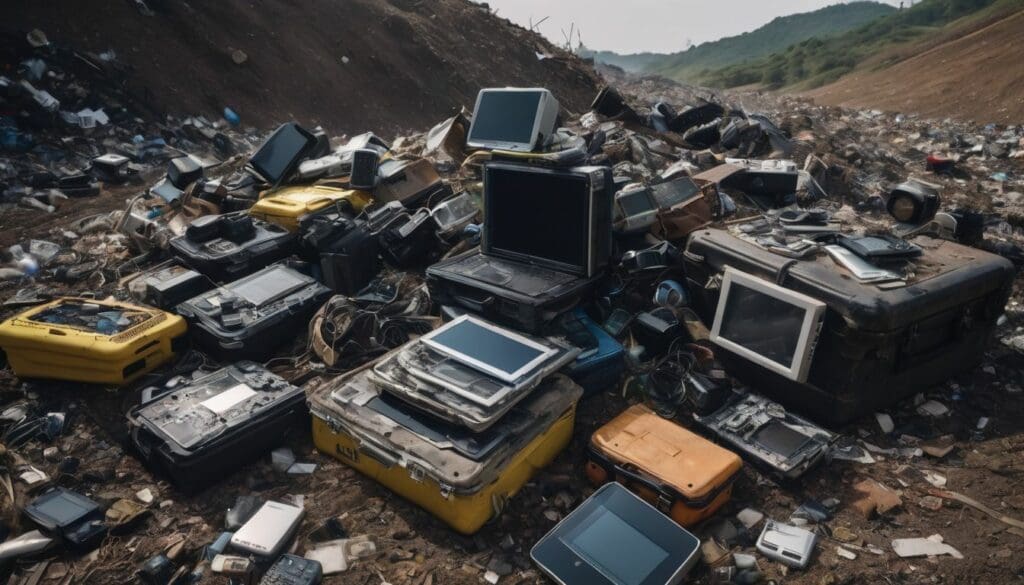As we casually connect our phones and laptops for a charge, it’s all too easy to ignore the environmental footprint that silently accumulates with every top-up. Each of us is entwined in this modern conundrum, acutely conscious that even a solitary smartphone can harbour over 60 different types of metals.
In our upcoming post, we’ll share with you straightforward steps that anyone can embrace to foster sustainability in consumer electronics – without having to relinquish your beloved devices.
Stay tuned for eco-wise revelations; together, let’s make choices that resonate with both technology and the planet.
Key Takeaways
- Eco – conscious consumers are driving the demand for sustainable consumer electronics, influencing companies to produce devices that have a lower environmental impact and support global conservation.
- Designers and manufacturers face challenges such as complex supply chains when implementing sustainability, but progress is being made through investment in eco-friendly practices and products.
- The circular economy is essential for reducing e-waste pollution and conserving resources, with initiatives like recycling programs and the use of renewable materials in manufacturing processes.
- Companies are increasingly adopting renewable energy sources to power production, creating longer-lasting products, using recycled materials, and educating consumers on responsible disposal to enhance sustainability.
- Global collaboration between designers, manufacturers, policymakers, and consumers is crucial for advancing sustainable development within the electronics industry.
The Growing Demand for Sustainable Consumer Electronics

Consumer concern for environmental impact is on the rise, leading to a growing demand for sustainable consumer electronics. With the projected increase in electronic consumption, there is a need for more ecofriendly options to meet consumer needs.
Increase in consumer concern
We’re seeing a clear shift in the market as eco-conscious consumers increasingly seek out sustainable consumer electronics. People are becoming more aware of environmental issues and their own carbon footprints, leading them to demand products that align with their values of responsibility and conservation.
This rising concern is pushing companies to rethink how they design, manufacture, and dispose of tech gadgets.
Ecofriendly products are no longer a niche interest; they’re rapidly becoming a mainstream desire. As we embrace renewable energy sources and champion the circular economy, our choices reflect a commitment to reducing electronic waste and supporting sustainable development.
We recognise that every purchase has an impact, so we opt for devices with longer product life cycles and lower resource-intensive profiles. Together, we’re driving change towards greener technology by insisting on higher standards for what we bring into our lives.
Projected growth of electronic consumption
The demand for sustainable consumer electronics is set to skyrocket in the coming years, as environmentally conscious individuals continue to push for eco-friendly products. With global collaboration and increasing awareness about the environmental impact of consumer electronics, we anticipate a significant surge in the adoption of sustainable design in electronics.
Consumers are becoming more eco-conscious and are supporting responsible consumption, which will further drive the projected growth of electronic consumption towards more resource-efficient and energy-saving options.
As sustainability benefits in consumer electronics become increasingly apparent, there is a shift towards renewable energy sources and green technology within the industry. This proactive approach drives the creation of eco-friendly products that prioritise energy efficiency and minimise environmental harm from resource-intensive production methods.
The Role of Design in Promoting Sustainability
Design plays a crucial role in promoting sustainability within the consumer electronics industry. It is a core driver for creating more sustainable options and meeting the demand of eco-conscious consumers.
Laws, regulations, and consumer preferences are also driving the creation of more sustainable products.
Design as a core driver for sustainability
Design plays a pivotal role in driving sustainability within the consumer electronics industry. By prioritising eco-friendly materials and energy-efficient features, designers can create products that align with the growing demand for sustainable options.
Incorporating renewable energy sources and reducing resource-intensive elements are essential aspects of design that contribute to environmentally conscious consumers’ preferences for eco-friendly electronics.
Moreover, global collaboration among designers, manufacturers, and policymakers is crucial for promoting sustainability in consumer electronics. Designing products with end-of-life recycling in mind not only minimises environmental impact but also supports the circular economy.
Creation of more sustainable options by laws and consumers
As we consider the role of design in promoting sustainability, it’s crucial to recognise how laws and consumer demand contribute to the creation of more sustainable options in consumer electronics.
Legislation focused on reducing electronic waste and promoting eco-friendly materials pushes manufacturers towards sustainable practices. Simultaneously, consumers are driving change by expressing preferences for products with minimal environmental impact.
The collaboration between lawmakers and environmentally conscious individuals is steering the industry towards innovative, resource-efficient, and eco-friendly electronics that align with global conservation efforts.
By embracing renewable energy sources in electronics production and supporting legislation that promotes sustainability, environmentally conscious consumers can actively shape the future of consumer electronics towards a more environmentally friendly direction.
Challenges and Opportunities in Implementing Sustainability

Implementing sustainability in consumer electronics presents challenges such as the complexity of supply chains and the need for global collaboration. However, there are also opportunities for innovation, cost savings, and meeting the demands of eco-conscious consumers.
Difficulty in implementation
Implementing sustainability in consumer electronics poses various challenges. Companies often face obstacles when attempting to transition to more eco-friendly practices, including high initial costs and the need for specialised knowledge and expertise.
Additionally, coordinating with suppliers and ensuring compliance across the entire supply chain can be complex. These difficulties can deter some companies from embracing sustainable practices, but as consumers continue to demand environmentally friendly products, the industry is making progress in addressing these challenges.
Moreover, shifting to renewable energy sources also presents its own set of implementation hurdles. Adapting and integrating renewable energy technologies into manufacturing processes requires significant investment and time, which may be perceived as a barrier by some companies.
Progress being made by the industry
Despite the challenges, the consumer electronics industry is making significant progress in promoting sustainability. Companies are increasingly investing in research and development to create eco-friendly products and reduce resource-intensive manufacturing processes.
Global collaboration for sustainability has also gained momentum, with companies working together to source materials responsibly and implement renewable energy solutions.
Eco-conscious consumers have been a driving force behind this progress, demanding more sustainable options from electronic manufacturers. As a result, brands are actively seeking ways to incorporate sustainable practices into their operations, leading to an increasing number of environmentally friendly electronic products on the market.
The Environmental Impact of Consumer Electronics
The environmental impact of consumer electronics is significant, with e-waste contributing to pollution and resource depletion. The importance of the circular economy is becoming more apparent in addressing sustainability in the industry.
Examples of sustainable practices such as recycling and using renewable materials are crucial for reducing the negative effects on the environment.
The impact of e-waste
E-waste poses a significant threat to the environment and human health. Discarded electronics contain hazardous materials such as lead, mercury, and cadmium that can leach into soil and water, causing pollution.
Consequently, proper disposal of e-waste is critical to mitigate these adverse effects. Many companies are embracing sustainable practices by implementing recycling programmes for electronic products to reduce the amount of e-waste ending up in landfills.
Furthermore, promoting awareness among consumers about responsible disposal methods is essential. Initiatives encouraging consumers to donate or recycle old electronics instead of throwing them away can significantly decrease e-waste accumulation.
Importance of the circular economy in addressing sustainability
The circular economy plays a crucial role in addressing sustainability in the consumer electronics industry. By promoting practices such as reusing, refurbishing, and recycling electronic products, the circular economy minimises waste and conserves resources.
It encourages the design of products that can be easily disassembled and their components reused or repurposed. Furthermore, embracing this concept helps reduce reliance on raw materials, lowering the environmental impact of resource-intensive products while supporting eco-friendly options.
Implementing a circular economy approach not only lessens the negative environmental effects associated with electronic waste but also fosters innovation and job creation within the sustainable technology sector.
Examples of sustainable practices in the industry
Transitioning from the importance of the circular economy in addressing sustainability, let’s explore examples of sustainable practices in the consumer electronics industry:
- Manufacturers are embracing renewable energy sources such as solar and wind power to reduce carbon emissions during production.
- Initiatives to increase product longevity, such as modular designs for easy repair and upgrade, are gaining traction among leading electronic companies.
- Electronic brands are prioritising the use of recycled materials in their products, thus reducing the demand for virgin resources.
- E-waste recycling programmes and take-back schemes have been implemented by several companies to responsibly manage end-of-life products.
- Collaboration with suppliers to ensure ethical sourcing practices for raw materials is becoming a standard practice in sustainable electronic manufacturing.
- The shift towards more energy – efficient devices and packaging materials is contributing to reduced environmental impact across the supply chain.
- Some brands are working towards achieving zero – waste goals in their production processes, striving for minimal waste sent to landfills.
- Consumer education campaigns promoting responsible disposal and encouraging extended product use are being adopted by industry players to promote sustainability awareness.
Conclusion
In conclusion, we must prioritise sustainability in consumer electronics. We can drive change through our choices as consumers. Manufacturers and lawmakers also play a crucial role in promoting sustainable practices.
Our collective efforts are vital in creating a more eco-friendly future for consumer electronics.
FAQs
1. Why is sustainability important in consumer electronics?
Sustainability is crucial in consumer electronics because it reduces the environmental impact of resource-intensive products by promoting eco-friendly alternatives and using renewable energy.
2. What are eco-friendly electronics?
Eco-friendly electronics are devices designed with environmentally safe materials, they consume less energy, and their production process aims to minimise waste.
3. How do consumers contribute to sustainability in electronics?
Consumers can help by choosing ecofriendly products, supporting companies that emphasise sustainability, and properly recycling old devices to reduce electronic waste.
4. Can renewable energy be used in making consumer electronics?
Yes, manufacturers can use renewable energy sources like solar or wind power during the production of consumer electronics which helps make them more sustainable.





